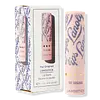What's inside
What's inside
 Key Ingredients
Key Ingredients

 Benefits
Benefits

 Concerns
Concerns

 Ingredients Side-by-side
Ingredients Side-by-side

Lanolin Oil
EmollientCaprylic/Capric Triglyceride
MaskingEuphorbia Cerifera Wax
Beeswax
Emulsion StabilisingLanolin
EmollientStearic Acid
CleansingSqualane
EmollientParaffin
PerfumingOlea Europaea Fruit Oil
MaskingPentylene Glycol
Skin ConditioningTocopherol
AntioxidantPhenoxyethanol
PreservativeStearyl Glycyrrhetinate
Skin ConditioningPanax Ginseng Root Extract
EmollientAloe Barbadensis Leaf Extract
EmollientLanolin
EmollientRicinus Communis Seed Oil
MaskingCapryloyl Glycerin/Sebacic Acid Copolymer
Skin ConditioningCera Alba
EmollientCaprylic/Capric Triglyceride
MaskingPersea Gratissima Oil
Skin ConditioningJojoba Esters
EmollientAroma
Butyrospermum Parkii Butter
Skin ConditioningEuphorbia Cerifera Cera
AstringentMangifera Indica Seed Butter
Skin ConditioningSimmondsia Chinensis Seed Oil
EmollientCopernicia Cerifera Cera
EmollientTocopherol
AntioxidantLanolin, Ricinus Communis Seed Oil, Capryloyl Glycerin/Sebacic Acid Copolymer, Cera Alba, Caprylic/Capric Triglyceride, Persea Gratissima Oil, Jojoba Esters, Aroma, Butyrospermum Parkii Butter, Euphorbia Cerifera Cera, Mangifera Indica Seed Butter, Simmondsia Chinensis Seed Oil, Copernicia Cerifera Cera, Tocopherol
 Reviews
Reviews

Ingredients Explained
These ingredients are found in both products.
Ingredients higher up in an ingredient list are typically present in a larger amount.
This ingredient is an emollient, solvent, and texture enhancer. It is considered a skin-softener by helping the skin prevent moisture loss.
It helps thicken a product's formula and makes it easier to spread by dissolving clumping compounds.
Caprylic Triglyceride is made by combining glycerin with coconut oil, forming a clear liquid.
While there is an assumption Caprylic Triglyceride can clog pores due to it being derived from coconut oil, there is no research supporting this.
Learn more about Caprylic/Capric TriglycerideLanolin is a wax secreted by animals with wool, such as sheep. It is a waterproof emollient.
Emollients help soften and moisturize the skin by creating a film. This film prevents moisture from escaping, helping the skin stay hydrated.
Unlike true fats, lanolin contains sterol esters instead of glycerides. It also contains fatty acids and alcohols.
Because lanolin comes from an animal, it is not considered vegan. Sheep secrete lanolin through sebaceous glands to help protect their skin from the environment.
The answer to this question depends on the brand itself. Being cruelty-free means a brand does not experiment or harm animals. We recommend looking into how brands source their lanolin. Lanolin is cruelty-free if it is gathered without harming the animal.
Learn more about LanolinTocopherol (also known as Vitamin E) is a common antioxidant used to help protect the skin from free-radicals and strengthen the skin barrier. It's also fat soluble - this means our skin is great at absorbing it.
Vitamin E also helps keep your natural skin lipids healthy. Your lipid skin barrier naturally consists of lipids, ceramides, and fatty acids. Vitamin E offers extra protection for your skin’s lipid barrier, keeping your skin healthy and nourished.
Another benefit is a bit of UV protection. Vitamin E helps reduce the damage caused by UVB rays. (It should not replace your sunscreen). Combining it with Vitamin C can decrease sunburned cells and hyperpigmentation after UV exposure.
You might have noticed Vitamin E + C often paired together. This is because it is great at stabilizing Vitamin C. Using the two together helps increase the effectiveness of both ingredients.
There are often claims that Vitamin E can reduce/prevent scarring, but these claims haven't been confirmed by scientific research.
Learn more about Tocopherol